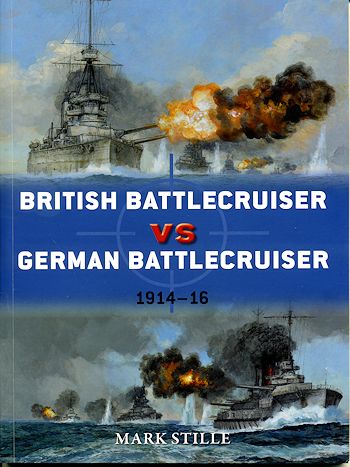 This latest
addition to Osprey's Duel series has two antagonists that are pretty
close to having been developed at the same time. Often in this series, one of
the two is newer than the other, which somewhat dilutes the comparison.
This latest
addition to Osprey's Duel series has two antagonists that are pretty
close to having been developed at the same time. Often in this series, one of
the two is newer than the other, which somewhat dilutes the comparison. |
Author: |
Mark Stille |
|
Publisher/Distributor |
Osprey Publishing |
|
Price |
$18.95 MSRP |
|
Reviewer: |
|
| Notes: |
80 pages, 7¼ x 9¼ inches, softcover ISBN: 978-1-78096-096-8 |
 This latest
addition to Osprey's Duel series has two antagonists that are pretty
close to having been developed at the same time. Often in this series, one of
the two is newer than the other, which somewhat dilutes the comparison.
This latest
addition to Osprey's Duel series has two antagonists that are pretty
close to having been developed at the same time. Often in this series, one of
the two is newer than the other, which somewhat dilutes the comparison.
The Battlecruiser was a development of British Admiral Fischer, who became First Sea Lord in 1904. The idea was to have a heavily armed, lightly armored and fast ship to work convoy escorts. Its foe was to be the enemy's armored cruisers. As such, the battle cruiser was to be larger, faster and more heavily armed than these ships. It was NOT designed to slug it out with enemy battleships, but was to be fast enough to disengage and flee to safety should it run up against the more heavily armored and bigger gunned ships.
Built in great secrecy, the first British ships of the class were armed with eight 12 inch naval rifles in four turrets; one fore, one aft and two on the sides. This provided a full broadside of six guns as the opposing side turrets had a relatively limited field of fire. For those wondering why the turrets were not superimposed as seen in much later ships, the issue was making the ships top-heavy as the barbettes and associated protection was quite weighty and ship builders wanted this as low to the water as was possible. Eventually, both sides did use this method of installing the big guns, but like everything, it was a learning process.
Once the Germans discovered what the British was doing, they developed their own battlecruisers. However, they did theirs a bit differently. The Germans did not have the 12 inch (later 14 inch) naval rifles of the British. They also believed in providing more armor protection, especially horizontal or deck armor. The result of this was that the German ships were slower and did not have the range of the British guns.
Another area where the two sides were different was in the powder they used. British powder was highly volatile and burned easily. The German powder was not quite so volatile and did not burn with the same ease. This would play an important part in later events. The Germans also trained more often and the result was that when the ships came up against each other, the superior optics of German rangefinders and training of their crews allowed more hits to be scored.
As with other books in this class, the book covers the initial development of the ships on both sides as well as the various classes and the improvements made with each class. As this is a 'vs' book, it covers the only two times during WWI when the types met and then only those engagements during the battles that were pertinent. Those two events were Dogger Bank and Jutland. In both cases, the German ships proved themselves superior to the British, even though strategically the Germans 'lost' both battles.
Two reasons for the successes of the Germans over the British. One was sloppy safety procedures where the British left open fire doors to quicken the pace of loading and firing. The second was the superior German gunnery. In the first case, every British battle cruiser that was destroyed during these two battles were destroyed because their magazines blew up. This resulted in the loss of nearly all their crews. This same thing happened during WWII with the HMS Hood. The lone German battlecruiser lost was basically pounded by British battleships with their larger guns. It did not blow up but was sunk due to all the damage it suffered. Other German battlecruisers were badly damaged, but returned to port to be repaired. In the end, it was realized that the battlecruiser was a dead end and none were developed after the war.
It makes for an excellent read with superb period photos and some excellent art work and drawings to help us get an idea of what these ships were like. A book that no WWI naval fan should be without.
December 2013
For more on the complete line of Osprey books, visit www.ospreypublishing.com. In the US, it is Osprey Direct at 443 Park Avenue South, New York, NY 10016, where you can get a catalogue of available books.
If you would like your product reviewed fairly and quickly, please contact me or see other details in the Note to Contributors.